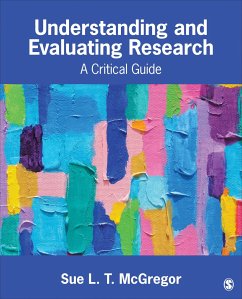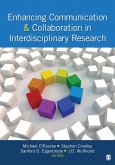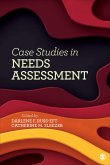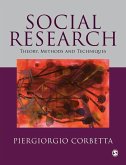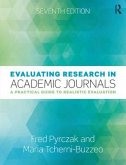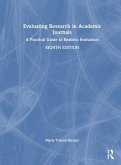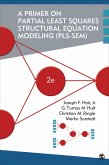- Broschiertes Buch
- Merkliste
- Auf die Merkliste
- Bewerten Bewerten
- Teilen
- Produkt teilen
- Produkterinnerung
- Produkterinnerung
Understanding and Evaluating Research: A Critical Guide shows students how to be critical consumers of research and to appreciate the power of methodology as it shapes the research question, the use of theory in the study, the methods used, and how the outcomes are reported.
Andere Kunden interessierten sich auch für
![Enhancing Communication & Collaboration in Interdisciplinary Research Enhancing Communication & Collaboration in Interdisciplinary Research]() Enhancing Communication & Collaboration in Interdisciplinary Research94,99 €
Enhancing Communication & Collaboration in Interdisciplinary Research94,99 €![Case Studies in Needs Assessment Case Studies in Needs Assessment]() Case Studies in Needs Assessment42,99 €
Case Studies in Needs Assessment42,99 €![Social Research Social Research]() Piergiorgio CorbettaSocial Research83,99 €
Piergiorgio CorbettaSocial Research83,99 €![Evaluating Research in Academic Journals Evaluating Research in Academic Journals]() Maria Tcherni-Buzzeo (USA University of New Haven)Evaluating Research in Academic Journals80,99 €
Maria Tcherni-Buzzeo (USA University of New Haven)Evaluating Research in Academic Journals80,99 €![Evaluating Research in Academic Journals Evaluating Research in Academic Journals]() Maria Tcherni-BuzzeoEvaluating Research in Academic Journals60,99 €
Maria Tcherni-BuzzeoEvaluating Research in Academic Journals60,99 €![Evaluating Research in Academic Journals Evaluating Research in Academic Journals]() Maria Tcherni-BuzzeoEvaluating Research in Academic Journals189,99 €
Maria Tcherni-BuzzeoEvaluating Research in Academic Journals189,99 €![A Primer on Partial Least Squares Structural Equation Modeling (PLS-SEM) A Primer on Partial Least Squares Structural Equation Modeling (PLS-SEM)]() Joe HairA Primer on Partial Least Squares Structural Equation Modeling (PLS-SEM)84,99 €
Joe HairA Primer on Partial Least Squares Structural Equation Modeling (PLS-SEM)84,99 €-
-
-
Understanding and Evaluating Research: A Critical Guide shows students how to be critical consumers of research and to appreciate the power of methodology as it shapes the research question, the use of theory in the study, the methods used, and how the outcomes are reported.
Hinweis: Dieser Artikel kann nur an eine deutsche Lieferadresse ausgeliefert werden.
Hinweis: Dieser Artikel kann nur an eine deutsche Lieferadresse ausgeliefert werden.
Produktdetails
- Produktdetails
- Verlag: SAGE Publications Inc
- Seitenzahl: 600
- Erscheinungstermin: 29. November 2017
- Englisch
- Abmessung: 240mm x 192mm x 30mm
- Gewicht: 1124g
- ISBN-13: 9781506350950
- ISBN-10: 150635095X
- Artikelnr.: 48431888
- Herstellerkennzeichnung
- Libri GmbH
- Europaallee 1
- 36244 Bad Hersfeld
- gpsr@libri.de
- Verlag: SAGE Publications Inc
- Seitenzahl: 600
- Erscheinungstermin: 29. November 2017
- Englisch
- Abmessung: 240mm x 192mm x 30mm
- Gewicht: 1124g
- ISBN-13: 9781506350950
- ISBN-10: 150635095X
- Artikelnr.: 48431888
- Herstellerkennzeichnung
- Libri GmbH
- Europaallee 1
- 36244 Bad Hersfeld
- gpsr@libri.de
Dr. Sue L. T. McGregor (Professor Emerita) is a Canadian home economist (more than 45 years) recently retired from Mount Saint Vincent University, Halifax Nova Scotia. She was one of the lead architects for the interuniversity doctoral program in educational studies, serving as its inaugural Coordinator. She has a keen interest in home economics philosophy, transdisciplinarity, and consumer studies. She is a TheAtlas Fellow (transdisciplinarity), a Docent in Home Economics at the University of Helsinki, the Marjorie M. Brown Distinguished Professor (home economics leadership), the Karpatkin International Consumer Fellow, and she received the TOPACE International Award (Berlin) for distinguished international consumer scholar. Affiliated with 20 professional journals, she has 160 peer-reviewed publications, 60 book chapters, 10 monographs, and four books. She has delivered 27 keynotes and invited talks in 12 countries. Dr. McGregor is Principal Consultant for The McGregor Consulting Group (1991) http://www.consultmcgregor.com, sue.mcgregor@msvu.ca
PART I
INTRODUCTION Chapter 1
Critical Research Literacy Chapter Summary Review and Discussion Questions PART II
PHILOSOPHICAL AND THEORETICAL ASPECTS OF RESEARCH Chapter 2
Research Methodologies Empirical, Interpretive, and Critical Methodologies Quantitative, Qualitative, and Mixed Methods Methodologies Research Methodology and Research Question Alignment Writing the Research Methodology Section of a Paper Chapter Summary Review and Discussion Questions Chapter 3
Conceptual Frameworks, Theories, and Models Introduction Role of Theory in Research Inquiries Concepts and Constructs Conceptual Frameworks Theories Writing the Theoretical or Conceptual Framework Section of a Paper Models Chapter Summary Review and Discussion Questions PART III
ORIENTING AND SUPPORTIVE ELEMENTS OF RESEARCH Chapter 4
Orienting and Supportive Elements of a Journal Article Introduction Authors
Names, Credentials, and Affiliations Article Title Abstracts Keywords References Footnotes and Endnotes Appendices Acknowledgements Biographies Chapter Summary Review and Discussion Questions Chapter 5
Peer-Reviewed Journals Introduction Journal Editor, Editorial Boards, and Facilitating Editors Peer Review Process Acceptance Rates Journal Impact Factors Journal Title Journal Volume, Issue, and Pagination Year of Publication and Article Placement in Issue Special Topic and Themed Issues Electronic Journals Open Access Journals Chapter Summary Review and Discussion Questions PART IV
RESEARCH JUSTIFICATIONS, AUGMENTATION, AND RATIONALES Chapter 6
Introduction and Research Questions Introduction Etymological Roots Opening Sentences and Opening Points in an Introduction Six Approaches to Writing Introductions Delimitations Chapter Summary Review and Discussion Questions Chapter 7
Literature Review Introduction Etymology and Definition of a Literature Review Purposes of a Literature Review When to Conduct a Literature Review Conducting a Literature Search Critically Reviewing the Collection of Literature Writing the Literature Review Section Characteristics of a Good Literature Review Technical Elements of Writing Effective Literature Review Sections Chapter Summary Review and Discussion Questions PART V
RESEARCH DESIGN AND RESEARCH METHODS Chapter 8
Overview of Research Design and Methods Introduction Etymology and Definition of Methods and Research Design Research Design Methods Integrity of Research Designs Technical Aspects of Reporting Methods Chapter Summary Review and Discussion Questions Chapter 9
Reporting Qualitative Research Methods Introduction Qualitative Emergent Research Designs Types of Qualitative Research Designs Methods Appropriate for Qualitative Research Qualitative Site Selection and Access Qualitative Sampling Researcher
s Role Qualitative Ethical Considerations Qualitative Data Collection Qualitative Data Management, Security, and Storage Integrity of Qualitative Research Designs Qualitative Data Analysis Qualitative Study Limitations Chapter Summary Review and Discussion Questions Chapter 10
Reporting Quantitative Methods and Mixed Methods Research Introduction Quantitative Research Design Mixed Methods Research Design Chapter Summary Review and Discussion Questions PART VI
RESULTS AND FINDINGS Chapter 11
Statistical Literacy and Conventions Introduction History of Statistics Laws of Probability and Chance Statistical Literacy Types of Statistical Data Statistical Variables Experimental and Nonexperimental Research Chapter Summary Review and Discussion Questions Chapter 12
Descriptive and Inferential Statistics Introduction Basic Differences Between Descriptive and Inferential Statistics Descriptive Statistics Association and Causation Inferential Statistics Conclusion Chapter Summary Review and Discussion Questions Chapter 13
Results and Findings Introduction Distinguishing Between Results and Findings Purpose of Results or Findings Section Reporting Qualitative Findings Reporting Quantitative Results Reporting Mixed Methods Results and Findings Conclusions: Unique Challenges of these Approaches Chapter Summary Review and Discussion Questions PART VII
DISCUSSION, CONCLUSIONS, AND RECOMMENDATIONS Chapter 14
Discussion Introduction Discussion Defined Discussion Relative to Results and Findings Purpose of Discussion Discussion and the Concept of Significance Fundamental Questions to Address in the Discussion Limitations Organizing the Discussion Section Staying Focused and On Topic Ensuring Strong and Responsible Discussions Technical Strategies for Discussion Sections Chapter Summary Review and Discussion Questions Chapter 15
Conclusions Introduction Conclusion Defined Relating Conclusions to Discussion and Summaries Purpose of Conclusions Closing Strategies for Effective Conclusions Things to Avoid in the Conclusions Section Technical Strategies for Writing Effective Conclusions Chapter Summary Review and Discussion Questions Chapter 16
Recommendations Introduction Recommend Defined Logical Connections Informing Recommendations Research Versus Nonresearch Recommendations Audiences for Recommendations Characteristics of Effective Recommendations Language for Communicating Recommendations Crafting and Organizing Effective Recommendations Technical Strategies for Presenting Recommendations Chapter Summary Review and Discussion Questions PART VIII
ARGUMENTATIVE ESSAYS AND THEORETICAL PAPERS Chapter 17
Argumentative Essays: Position, Discussion, and Think-Piece Papers Introduction Argumentative Essays Comparing Position, Discussion, and Think-Piece Papers Format for Argumentative Papers Persuasive Writing and Rhetorical Appeals Deductive and Inductive Argumentation Chapter 18
Conceptual and Theoretical Papers
INTRODUCTION Chapter 1
Critical Research Literacy Chapter Summary Review and Discussion Questions PART II
PHILOSOPHICAL AND THEORETICAL ASPECTS OF RESEARCH Chapter 2
Research Methodologies Empirical, Interpretive, and Critical Methodologies Quantitative, Qualitative, and Mixed Methods Methodologies Research Methodology and Research Question Alignment Writing the Research Methodology Section of a Paper Chapter Summary Review and Discussion Questions Chapter 3
Conceptual Frameworks, Theories, and Models Introduction Role of Theory in Research Inquiries Concepts and Constructs Conceptual Frameworks Theories Writing the Theoretical or Conceptual Framework Section of a Paper Models Chapter Summary Review and Discussion Questions PART III
ORIENTING AND SUPPORTIVE ELEMENTS OF RESEARCH Chapter 4
Orienting and Supportive Elements of a Journal Article Introduction Authors
Names, Credentials, and Affiliations Article Title Abstracts Keywords References Footnotes and Endnotes Appendices Acknowledgements Biographies Chapter Summary Review and Discussion Questions Chapter 5
Peer-Reviewed Journals Introduction Journal Editor, Editorial Boards, and Facilitating Editors Peer Review Process Acceptance Rates Journal Impact Factors Journal Title Journal Volume, Issue, and Pagination Year of Publication and Article Placement in Issue Special Topic and Themed Issues Electronic Journals Open Access Journals Chapter Summary Review and Discussion Questions PART IV
RESEARCH JUSTIFICATIONS, AUGMENTATION, AND RATIONALES Chapter 6
Introduction and Research Questions Introduction Etymological Roots Opening Sentences and Opening Points in an Introduction Six Approaches to Writing Introductions Delimitations Chapter Summary Review and Discussion Questions Chapter 7
Literature Review Introduction Etymology and Definition of a Literature Review Purposes of a Literature Review When to Conduct a Literature Review Conducting a Literature Search Critically Reviewing the Collection of Literature Writing the Literature Review Section Characteristics of a Good Literature Review Technical Elements of Writing Effective Literature Review Sections Chapter Summary Review and Discussion Questions PART V
RESEARCH DESIGN AND RESEARCH METHODS Chapter 8
Overview of Research Design and Methods Introduction Etymology and Definition of Methods and Research Design Research Design Methods Integrity of Research Designs Technical Aspects of Reporting Methods Chapter Summary Review and Discussion Questions Chapter 9
Reporting Qualitative Research Methods Introduction Qualitative Emergent Research Designs Types of Qualitative Research Designs Methods Appropriate for Qualitative Research Qualitative Site Selection and Access Qualitative Sampling Researcher
s Role Qualitative Ethical Considerations Qualitative Data Collection Qualitative Data Management, Security, and Storage Integrity of Qualitative Research Designs Qualitative Data Analysis Qualitative Study Limitations Chapter Summary Review and Discussion Questions Chapter 10
Reporting Quantitative Methods and Mixed Methods Research Introduction Quantitative Research Design Mixed Methods Research Design Chapter Summary Review and Discussion Questions PART VI
RESULTS AND FINDINGS Chapter 11
Statistical Literacy and Conventions Introduction History of Statistics Laws of Probability and Chance Statistical Literacy Types of Statistical Data Statistical Variables Experimental and Nonexperimental Research Chapter Summary Review and Discussion Questions Chapter 12
Descriptive and Inferential Statistics Introduction Basic Differences Between Descriptive and Inferential Statistics Descriptive Statistics Association and Causation Inferential Statistics Conclusion Chapter Summary Review and Discussion Questions Chapter 13
Results and Findings Introduction Distinguishing Between Results and Findings Purpose of Results or Findings Section Reporting Qualitative Findings Reporting Quantitative Results Reporting Mixed Methods Results and Findings Conclusions: Unique Challenges of these Approaches Chapter Summary Review and Discussion Questions PART VII
DISCUSSION, CONCLUSIONS, AND RECOMMENDATIONS Chapter 14
Discussion Introduction Discussion Defined Discussion Relative to Results and Findings Purpose of Discussion Discussion and the Concept of Significance Fundamental Questions to Address in the Discussion Limitations Organizing the Discussion Section Staying Focused and On Topic Ensuring Strong and Responsible Discussions Technical Strategies for Discussion Sections Chapter Summary Review and Discussion Questions Chapter 15
Conclusions Introduction Conclusion Defined Relating Conclusions to Discussion and Summaries Purpose of Conclusions Closing Strategies for Effective Conclusions Things to Avoid in the Conclusions Section Technical Strategies for Writing Effective Conclusions Chapter Summary Review and Discussion Questions Chapter 16
Recommendations Introduction Recommend Defined Logical Connections Informing Recommendations Research Versus Nonresearch Recommendations Audiences for Recommendations Characteristics of Effective Recommendations Language for Communicating Recommendations Crafting and Organizing Effective Recommendations Technical Strategies for Presenting Recommendations Chapter Summary Review and Discussion Questions PART VIII
ARGUMENTATIVE ESSAYS AND THEORETICAL PAPERS Chapter 17
Argumentative Essays: Position, Discussion, and Think-Piece Papers Introduction Argumentative Essays Comparing Position, Discussion, and Think-Piece Papers Format for Argumentative Papers Persuasive Writing and Rhetorical Appeals Deductive and Inductive Argumentation Chapter 18
Conceptual and Theoretical Papers
PART I
INTRODUCTION Chapter 1
Critical Research Literacy Chapter Summary Review and Discussion Questions PART II
PHILOSOPHICAL AND THEORETICAL ASPECTS OF RESEARCH Chapter 2
Research Methodologies Empirical, Interpretive, and Critical Methodologies Quantitative, Qualitative, and Mixed Methods Methodologies Research Methodology and Research Question Alignment Writing the Research Methodology Section of a Paper Chapter Summary Review and Discussion Questions Chapter 3
Conceptual Frameworks, Theories, and Models Introduction Role of Theory in Research Inquiries Concepts and Constructs Conceptual Frameworks Theories Writing the Theoretical or Conceptual Framework Section of a Paper Models Chapter Summary Review and Discussion Questions PART III
ORIENTING AND SUPPORTIVE ELEMENTS OF RESEARCH Chapter 4
Orienting and Supportive Elements of a Journal Article Introduction Authors
Names, Credentials, and Affiliations Article Title Abstracts Keywords References Footnotes and Endnotes Appendices Acknowledgements Biographies Chapter Summary Review and Discussion Questions Chapter 5
Peer-Reviewed Journals Introduction Journal Editor, Editorial Boards, and Facilitating Editors Peer Review Process Acceptance Rates Journal Impact Factors Journal Title Journal Volume, Issue, and Pagination Year of Publication and Article Placement in Issue Special Topic and Themed Issues Electronic Journals Open Access Journals Chapter Summary Review and Discussion Questions PART IV
RESEARCH JUSTIFICATIONS, AUGMENTATION, AND RATIONALES Chapter 6
Introduction and Research Questions Introduction Etymological Roots Opening Sentences and Opening Points in an Introduction Six Approaches to Writing Introductions Delimitations Chapter Summary Review and Discussion Questions Chapter 7
Literature Review Introduction Etymology and Definition of a Literature Review Purposes of a Literature Review When to Conduct a Literature Review Conducting a Literature Search Critically Reviewing the Collection of Literature Writing the Literature Review Section Characteristics of a Good Literature Review Technical Elements of Writing Effective Literature Review Sections Chapter Summary Review and Discussion Questions PART V
RESEARCH DESIGN AND RESEARCH METHODS Chapter 8
Overview of Research Design and Methods Introduction Etymology and Definition of Methods and Research Design Research Design Methods Integrity of Research Designs Technical Aspects of Reporting Methods Chapter Summary Review and Discussion Questions Chapter 9
Reporting Qualitative Research Methods Introduction Qualitative Emergent Research Designs Types of Qualitative Research Designs Methods Appropriate for Qualitative Research Qualitative Site Selection and Access Qualitative Sampling Researcher
s Role Qualitative Ethical Considerations Qualitative Data Collection Qualitative Data Management, Security, and Storage Integrity of Qualitative Research Designs Qualitative Data Analysis Qualitative Study Limitations Chapter Summary Review and Discussion Questions Chapter 10
Reporting Quantitative Methods and Mixed Methods Research Introduction Quantitative Research Design Mixed Methods Research Design Chapter Summary Review and Discussion Questions PART VI
RESULTS AND FINDINGS Chapter 11
Statistical Literacy and Conventions Introduction History of Statistics Laws of Probability and Chance Statistical Literacy Types of Statistical Data Statistical Variables Experimental and Nonexperimental Research Chapter Summary Review and Discussion Questions Chapter 12
Descriptive and Inferential Statistics Introduction Basic Differences Between Descriptive and Inferential Statistics Descriptive Statistics Association and Causation Inferential Statistics Conclusion Chapter Summary Review and Discussion Questions Chapter 13
Results and Findings Introduction Distinguishing Between Results and Findings Purpose of Results or Findings Section Reporting Qualitative Findings Reporting Quantitative Results Reporting Mixed Methods Results and Findings Conclusions: Unique Challenges of these Approaches Chapter Summary Review and Discussion Questions PART VII
DISCUSSION, CONCLUSIONS, AND RECOMMENDATIONS Chapter 14
Discussion Introduction Discussion Defined Discussion Relative to Results and Findings Purpose of Discussion Discussion and the Concept of Significance Fundamental Questions to Address in the Discussion Limitations Organizing the Discussion Section Staying Focused and On Topic Ensuring Strong and Responsible Discussions Technical Strategies for Discussion Sections Chapter Summary Review and Discussion Questions Chapter 15
Conclusions Introduction Conclusion Defined Relating Conclusions to Discussion and Summaries Purpose of Conclusions Closing Strategies for Effective Conclusions Things to Avoid in the Conclusions Section Technical Strategies for Writing Effective Conclusions Chapter Summary Review and Discussion Questions Chapter 16
Recommendations Introduction Recommend Defined Logical Connections Informing Recommendations Research Versus Nonresearch Recommendations Audiences for Recommendations Characteristics of Effective Recommendations Language for Communicating Recommendations Crafting and Organizing Effective Recommendations Technical Strategies for Presenting Recommendations Chapter Summary Review and Discussion Questions PART VIII
ARGUMENTATIVE ESSAYS AND THEORETICAL PAPERS Chapter 17
Argumentative Essays: Position, Discussion, and Think-Piece Papers Introduction Argumentative Essays Comparing Position, Discussion, and Think-Piece Papers Format for Argumentative Papers Persuasive Writing and Rhetorical Appeals Deductive and Inductive Argumentation Chapter 18
Conceptual and Theoretical Papers
INTRODUCTION Chapter 1
Critical Research Literacy Chapter Summary Review and Discussion Questions PART II
PHILOSOPHICAL AND THEORETICAL ASPECTS OF RESEARCH Chapter 2
Research Methodologies Empirical, Interpretive, and Critical Methodologies Quantitative, Qualitative, and Mixed Methods Methodologies Research Methodology and Research Question Alignment Writing the Research Methodology Section of a Paper Chapter Summary Review and Discussion Questions Chapter 3
Conceptual Frameworks, Theories, and Models Introduction Role of Theory in Research Inquiries Concepts and Constructs Conceptual Frameworks Theories Writing the Theoretical or Conceptual Framework Section of a Paper Models Chapter Summary Review and Discussion Questions PART III
ORIENTING AND SUPPORTIVE ELEMENTS OF RESEARCH Chapter 4
Orienting and Supportive Elements of a Journal Article Introduction Authors
Names, Credentials, and Affiliations Article Title Abstracts Keywords References Footnotes and Endnotes Appendices Acknowledgements Biographies Chapter Summary Review and Discussion Questions Chapter 5
Peer-Reviewed Journals Introduction Journal Editor, Editorial Boards, and Facilitating Editors Peer Review Process Acceptance Rates Journal Impact Factors Journal Title Journal Volume, Issue, and Pagination Year of Publication and Article Placement in Issue Special Topic and Themed Issues Electronic Journals Open Access Journals Chapter Summary Review and Discussion Questions PART IV
RESEARCH JUSTIFICATIONS, AUGMENTATION, AND RATIONALES Chapter 6
Introduction and Research Questions Introduction Etymological Roots Opening Sentences and Opening Points in an Introduction Six Approaches to Writing Introductions Delimitations Chapter Summary Review and Discussion Questions Chapter 7
Literature Review Introduction Etymology and Definition of a Literature Review Purposes of a Literature Review When to Conduct a Literature Review Conducting a Literature Search Critically Reviewing the Collection of Literature Writing the Literature Review Section Characteristics of a Good Literature Review Technical Elements of Writing Effective Literature Review Sections Chapter Summary Review and Discussion Questions PART V
RESEARCH DESIGN AND RESEARCH METHODS Chapter 8
Overview of Research Design and Methods Introduction Etymology and Definition of Methods and Research Design Research Design Methods Integrity of Research Designs Technical Aspects of Reporting Methods Chapter Summary Review and Discussion Questions Chapter 9
Reporting Qualitative Research Methods Introduction Qualitative Emergent Research Designs Types of Qualitative Research Designs Methods Appropriate for Qualitative Research Qualitative Site Selection and Access Qualitative Sampling Researcher
s Role Qualitative Ethical Considerations Qualitative Data Collection Qualitative Data Management, Security, and Storage Integrity of Qualitative Research Designs Qualitative Data Analysis Qualitative Study Limitations Chapter Summary Review and Discussion Questions Chapter 10
Reporting Quantitative Methods and Mixed Methods Research Introduction Quantitative Research Design Mixed Methods Research Design Chapter Summary Review and Discussion Questions PART VI
RESULTS AND FINDINGS Chapter 11
Statistical Literacy and Conventions Introduction History of Statistics Laws of Probability and Chance Statistical Literacy Types of Statistical Data Statistical Variables Experimental and Nonexperimental Research Chapter Summary Review and Discussion Questions Chapter 12
Descriptive and Inferential Statistics Introduction Basic Differences Between Descriptive and Inferential Statistics Descriptive Statistics Association and Causation Inferential Statistics Conclusion Chapter Summary Review and Discussion Questions Chapter 13
Results and Findings Introduction Distinguishing Between Results and Findings Purpose of Results or Findings Section Reporting Qualitative Findings Reporting Quantitative Results Reporting Mixed Methods Results and Findings Conclusions: Unique Challenges of these Approaches Chapter Summary Review and Discussion Questions PART VII
DISCUSSION, CONCLUSIONS, AND RECOMMENDATIONS Chapter 14
Discussion Introduction Discussion Defined Discussion Relative to Results and Findings Purpose of Discussion Discussion and the Concept of Significance Fundamental Questions to Address in the Discussion Limitations Organizing the Discussion Section Staying Focused and On Topic Ensuring Strong and Responsible Discussions Technical Strategies for Discussion Sections Chapter Summary Review and Discussion Questions Chapter 15
Conclusions Introduction Conclusion Defined Relating Conclusions to Discussion and Summaries Purpose of Conclusions Closing Strategies for Effective Conclusions Things to Avoid in the Conclusions Section Technical Strategies for Writing Effective Conclusions Chapter Summary Review and Discussion Questions Chapter 16
Recommendations Introduction Recommend Defined Logical Connections Informing Recommendations Research Versus Nonresearch Recommendations Audiences for Recommendations Characteristics of Effective Recommendations Language for Communicating Recommendations Crafting and Organizing Effective Recommendations Technical Strategies for Presenting Recommendations Chapter Summary Review and Discussion Questions PART VIII
ARGUMENTATIVE ESSAYS AND THEORETICAL PAPERS Chapter 17
Argumentative Essays: Position, Discussion, and Think-Piece Papers Introduction Argumentative Essays Comparing Position, Discussion, and Think-Piece Papers Format for Argumentative Papers Persuasive Writing and Rhetorical Appeals Deductive and Inductive Argumentation Chapter 18
Conceptual and Theoretical Papers

